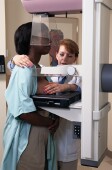
WEDNESDAY, Nov. 21 (HealthDay News) — Although mammograms have excelled at detecting breast cancer at early stages, when it can still be treated, mammography screening has failed to reduce cases of more serious late-stage disease, according to a new study.
The researchers also estimate that almost one-third of women with breast cancer are overdiagnosed via mammography — meaning that they do not actually have cancer or they have a type of breast cancer that would not develop into potentially deadly late-stage disease.
The rate of overdiagnosis is based on data showing that the number of cases of early-stage breast cancer has grown since the mid-1980s, when mammography screening started becoming common, but that the rate of advanced disease has dropped only slightly.
“The most striking observation is that we’ve done nothing to really improve late-stage disease,” said Dr. Archie Bleyer, chair of the Institutional Review Board at St. Charles Health System in Oregon, and lead author of the study. Late-stage disease that has spread beyond the breast area, known as distant disease, is much more lethal and is associated with only a 25 percent five-year survival rate.
The study is published in the Nov. 22 issue of the New England Journal of Medicine.
The news is not all bad: breast cancer is a less deadly disease than it was 30 years ago. According to the study, there has been a 28 percent decrease in breast cancer deaths since the mid-1970s, from 71 per 100,000 women down to 51 per 100,000.
However, Bleyer attributes that improvement to better treatments.
“All the progress we’ve made is due to treatment,” Bleyer said. “We’ve been attributing it to early screening and detection, but the [steady] incidence of late-stage means we haven’t really done anything to detect [deadly forms of] breast cancer earlier.”
One expert believes regular mammography screening should get some credit, however.
“Many experts agree that there is some degree of overdiagnosis and overtreatment,” said Dr. Len Lichtenfeld, deputy chief medical officer of the American Cancer Society. However, “you can’t have a significant decline in mortality unless you’re doing something right,” he added. “I think it is a combination of mammography, increased awareness and better treatment.”
Lichtenfeld added that it is very difficult to assess how much mammography, on its own, is contributing to reductions in breast cancer deaths.
The true overdiagnosis rate in the United States is difficult to know because it can vary based on how researchers analyze the numbers, Lichtenfeld noted.
“Today’s paper says that mammography has limited benefit, but tomorrow’s paper may say that it has significant benefit,” he said.
Amid all this, the American Cancer Society continues to recommend that women get annual mammograms starting at 40 years of age, Lichtenfeld said.
For his part, Bleyer thinks that women should get mammograms every other year between the ages of 50 and 70, similar to controversial guidelines issued by the U.S. Preventive Services Task Force in 2009.
Even though Bleyer’s study did not find a decrease in the cases of distant disease, it estimated that the rate of regional disease decreased by 8 percent. Regional disease is a form of late-stage cancer, but unlike distant disease, it has only spread within the area of the breasts, usually the lymph nodes, and is more treatable.
To estimate the rate of overdiagnosis, Bleyer and his colleague used U.S. data from between 1976 and 2008 on breast cancer incidence and survival rates from the Surveillance, Epidemiology, and End Results (SEER) program. They also relied on survey data estimating how many women get mammograms.
The researchers found that incidence of early-stage breast cancer increased between the mid-1980s and 2000 among women 40 years and older, as the percentage of women getting mammograms was rising. Over the same years, cases of regional disease dipped by only 8 percent and cases of distant disease did not change at all.
Based on these findings, they estimated that 31 percent of women in 2008, or 70,000, were overdiagnosed. That has probably been the rate since the mid-1990s, and for the decade before that, it seemed to be about 20 percent, Bleyer said.
Between 1976 and 2008, a total of 1.3 million women in the United States were overdiagnosed, the researchers estimate.
The overdiagnosis rate was similar for all age groups over 40, although it was slightly higher among women between 50 and 70 years, who may be the ones most likely to have routine mammograms, Bleyer said. In contrast, the incidence of both early- and late-stage breast cancer was largely unchanged between 1976 and 2008 among women under 40 years, who do not receive mammogram screening.
Although Bleyer was surprised to discover that the United States had such a high overdiagnosis rate among women 40 years and older, “we are not the only one,” he said. Studies of Scandinavian populations estimated rates of breast cancer overdiagnosis between about 20 and 30 percent, while an Australian study put their rate at between 30 and 42 percent.
In addition to the questions that the current study raises about the ability of mammography to reduce breast cancer disease, mammography has its own downsides, such as causing anxiety and discomfort for women, Bleyer said. For women who are overdiagnosed, mammography can also lead to unnecessary treatment, such as surgery, chemo and radiation therapy.
More information
To learn more about breast cancer risk factors, visit the U.S. Centers for Disease Control and Prevention.

